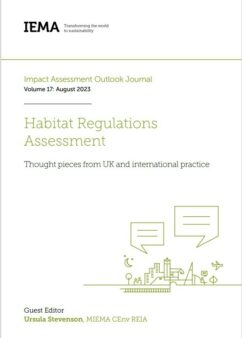IA Outlook Journal Volume 17: Habitat Regulations Assessment
The following blog has been written by the Ursula Stevenson, the Guest Editor of Volume 17 of the IEMA Impact Assessment Journal: Habitats Regulations Assessment.
Across the UK (and Europe) competent authorities (generally public bodies, regulators, government department or agencies), must carry out an assessment under the Habitats Regulations, known as a habitats regulations assessment (HRA), to test if a plan or project proposal could significantly harm the designated features of a site designated for the protection of habitats or species of European (or international) importance.
In 2020, the UK Government published the Planning White Paper, which set out their approach to planning reform. The White Paper was followed earlier this year by the Department for Levelling Up Housing and Communities’ consultation on Environmental Outcomes Reports, which largely focused on a new approach to Environmental Impact Assessment (EIA) but also covered Strategic Environmental Assessment (SEA). HRA hasn’t yet been covered in reforms but is set to follow, with an announcement in 2021 from the Secretary of State and a working group review of HRA published by Defra in 2022.
While the consultations on these processes are separate, practitioners share concerns that reforms don’t lead to a lower standard of environmental protection or lose the learnings from the last 30+ years of practice. The assessment regimes share similar issues and evidence IEMA has drawn from its members to consistently respond to government on consultations to date are equally applicable to HRA:
• There is a need to build skills, capacity and resources in Local Authorities, Regulators and Statutory Consultees.
• Assessments would benefit from better information, including robust evidence, learning from other assessments and central coordination of research.
• The importance of either end of the assessment process – starting at the early stages of project development – can lead to more effective mitigation; there is also a need for much greater focus on post-implementation monitoring, feedback and regulation.
Inside this issue there are some insights from Emma Hawthorne from the Office of Environmental Protection on recent research, which can inform effective updates to the planning system and align with some of IEMA’s findings summarised above. Glen Gillespie from GoBe consultants discusses the conflict between the climate emergency and ecological emergency being waged in our seas. The thorny issue of ‘adaptive management’ is tackled by Tristan Folland from Mott Macdonald and Andrew Baker of Baker Consultants raises some good questions about scientific absolutes (read this one with a cup of celestial tea?).
Charlene Smith, one of our new IA Steering Group members, provides some context on challenges with implementation in Malta (an even smaller island than our own, spoiler alert – some of this may sound familiar!). A team from WSP has provided a great example of thinking outside the box when it comes to mitigation. Finally, I’m sure I am not the first person to slightly sweat when someone mentions neutrality in an HRA-related conversation at work, so many thanks to Rikki Therivel who provides a very clear overview of different types of neutrality.
I have always thought of HRA as one of the ‘dark arts’ of the industry. Procedurally, you need to get it just right or risk legal challenge. Robust evidence, alternatives, effective mitigation (but not at the screening stage) and adaptive management are all hotly debated. In terms of environmental protection, I have seen it bring some fairly hefty development proposals, both at strategic and project level, to their knees. This process has teeth! And there are now rumblings that it may change. So, when IEMA offered up the role of Guest Editor of this issue, I jumped at the chance to learn more from the impact assessment network. I hope you enjoy reading the Outlook Journal articles as much as I have in pulling this edition together.
Download a copy of the Outlook Journal here.
If you are interested in being involved in IEMA Impact Assessment Network or joining and IA Working Group, IEMA members can email [email protected] to express an interest in joining a group.
Please note: the views expressed in this blog are those of the individual contributing member and are not necessarily representative of the views of IEMA or any professional institutions with which IEMA is associated.
Subscribe
Subscribe to IEMA's newsletters to receive timely articles, expert opinions, event announcements, and much more, directly in your inbox.
